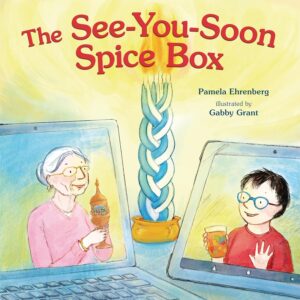In Pamela Ehrenberg’s picture book THE SEE-YOU-SOON SPICE BOX (Kar-Ben, 2025), illustrated by Gabby Grant, young Silas visits with his Great-Grandma Faye over video chat. Despite their distance, they explore family holidays, including Havdalah, together. With Great-Grandma Faye’s inspiration, Silas gets creative and finds a way to honor the tradition in a personal way. Featuring engaging illustrations, THE SEE-YOU-SOON SPICE BOX is a relatable, thoughtful story emphasizing that familial connection can be achieved in many ways. I am delighted to learn more about this sweet story. Welcome back, Pamela!
What inspired you to write a picture book that features Havdalah?
I love Havdalah! It wasn’t something my family did regularly growing up, but when my kids were little, we attended a program that sent us home with a photocopy of the Havdalah service, and it was so sweet (and short!!!) and beautiful! I found that with little kids, while Shabbat can definitely feel different from weekdays, in my experience it wasn’t typically restful … so to have this brief moment of quiet together, to bookend the tail end of Shabbat—that was something that this tired single mom really looked forward to and enjoyed.

photo credit: Alexandra Taylor
Although Silas and Great-Grandma Faye live apart, they communicate and share special moments, holidays, and family traditions via computer. It’s an interesting juxtaposition between ancient tradition and modern technology. What challenges did you face creating a story that integrated these two worlds?
What a great question—and you know, this makes me wonder if people thousands of years ago asked the same questions when there started to be a diaspora, and people had to figure out how it would work to continue their traditions from new locations. : ) I think technology is just the next step in this ongoing journey…and for young kids Silas’s age, who are “digital natives,” video calls are just another tool to call into service. In terms of challenges for the book—I remember some conversations with my editor, who then connected with the art director, as we thought about how the illustrations would include technology that felt authentic to each character (e.g., laptop vs. tablet) and also would hopefully still feel contemporary for as many years as children want to keep reading the story.
What were your thoughts when you saw Gabby Grant’s illustrations?
I love the way Gabby’s drawings bring the characters and their experiences to life!! You know, as someone who learned the “show-don’t-tell” rule of fiction-writing from a middle-grade-and-up perspective –using words to “show” the reader what the characters are experiencing – it was surprising for me to learn with my earlier picture books all the ways that picture books take this to a whole other level – that my words have to carve out space for whatever vision the illustrations brought to life on their own. I am so appreciative of the joyful storytelling that Gabby brings about in the illustrations!

You introduce some engaging concepts in the story, such as rhyming nicknames and the idea of “in-between.” Are these concepts part of your storytelling process, or did you intentionally create these learning opportunities for readers?
Oh, that is just how my brain works! The idea of “intentional learning opportunities” sounds so powerful and Authorial, but I usually find it’s as much as I can manage just to tell a story sometimes a critique partner or an editor will point out when it’s helpful to have a bit more learning—like what is Havdalah, so the story can be enjoyed by readers who may or may not have that particular previous knowledge—but I’d say that rhyming nicknames are something I’ve found fun at every age so far—and “in between” is something that has fascinated me at every age! It actually brings me comfort, now that I think about it, to realize that Great-Grandma Faye (in her late 80s?) still enjoys rhymes and also sees herself as in-between.
What do you hope readers and their parents take away from the story?
Really—I’d love for the story to spark a bit of resistance to what I’ve heard described as a loneliness epidemic. One great thing about Havdalah, as Silas & Great-Grandma Faye both enjoy, is that it comes every week no matter what—so meeting every week for a 10-minute virtual Havdalah can take away the exhausting need for coordinating overstuffed calendars. (When did our calendars get so overwhelming???) And at the same time—so many over-stretched, busy families have someone who lives by themselves and would so love a video call that happens on auto-pilot. It would make me so happy to hear from any readers who use The See-You-Soon Spice Box to fight back against loneliness.
Thank you, Pamela!
Pamela Ehrenberg’s previous picture books include Queen of the Hanukkah Dosas and Planting Parsley. Her middle-grade novel Detour Ahead (co-authored with Tracy López) was a National Jewish Book Award finalist. She and her children live in Washington, D.C.